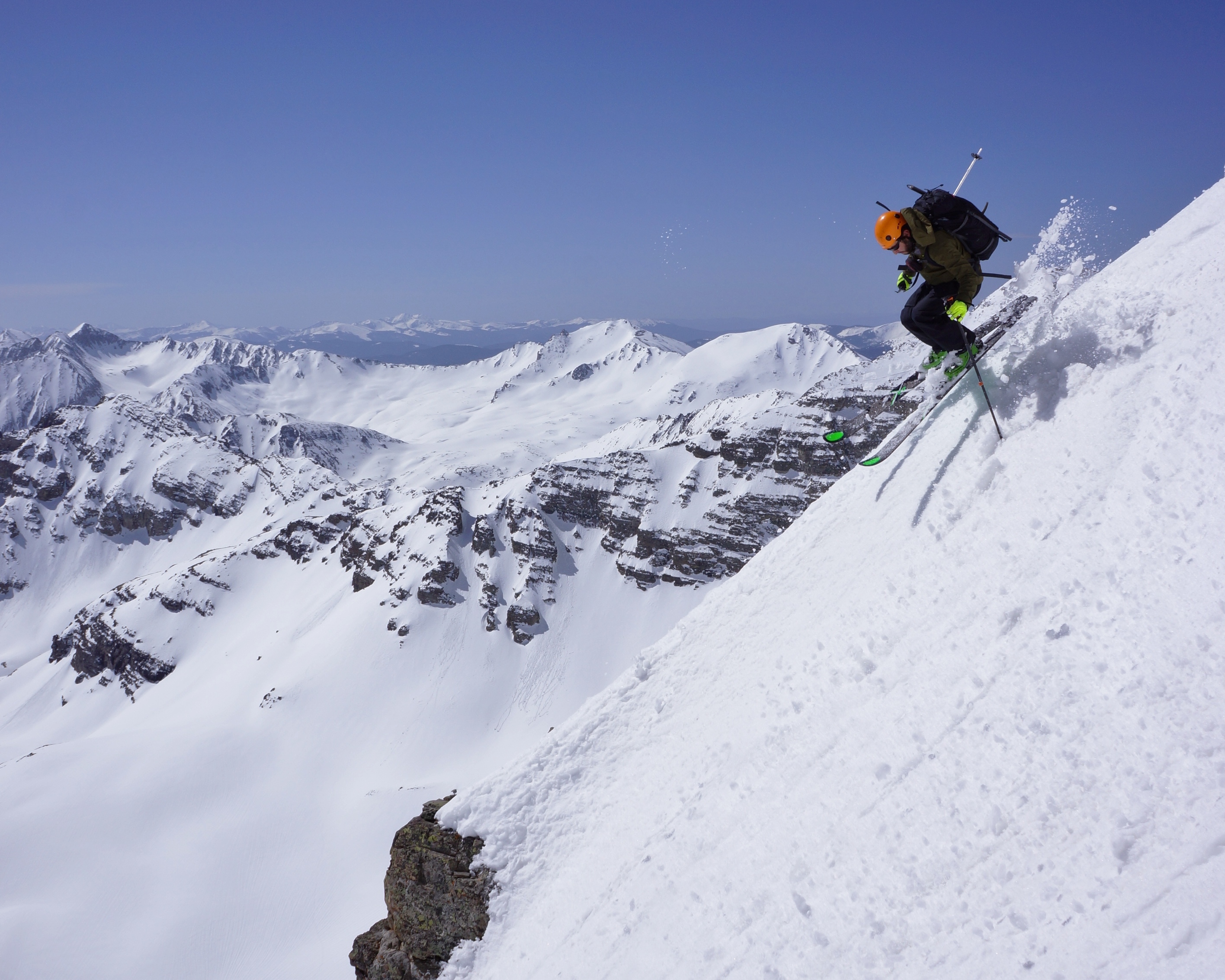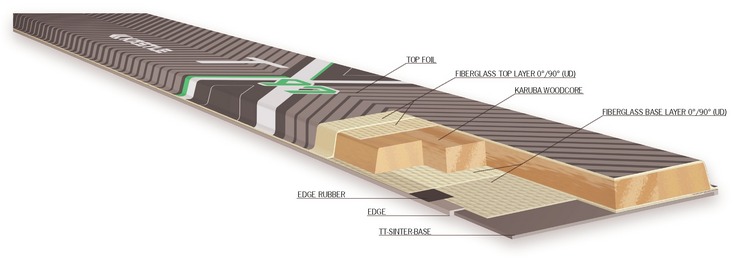
With the maniac trip report writers doing what they do best, (writing kick ass trip reports) I figured I might as well toss a gear review into the mix. And since ski season is JUST around the corner, a ski review is only fitting.
So…..today we’ll be talking the Kastle TX97 (177cm length – 128x97x117mm with a 22m turning radius). But before we begin the review, a brief history of the company is in order. Kastle has been making skis since 1924 when Anton Kastle made his first pair in Austria (all ash construction). Several winter Olympians won gold medals using Kastle skis (3 gold’s in 1952 and 2 gold’s and 18 other medals in the 1956 olympics). As a result of the 1950’s olympic successes and various other skiing championship wins, Kastle quickly became an internationally recognized brand. In 1978 Kastle continued to expand the reach of the brand by making an extremely light weight ski designed specifically for mountaineers – the “tour randonnee”. In spite of several other Olympic medals in the 70’s and 80’s, Kastle seemed to lose some momentum in terms of brand recognition. Speculation aside, the company did experience a few different changes in ownership over the years. Never less, the mid to late 2000’s saw resurgence at Kastle with what their marketing department calls “the comeback collection” vis-a-vis Chris Davenport.
Presently, Kastle makes a disgustingly huge array of ski models – the RX, LX, MX, FX, BMX, TX, XX, and XX JR. Whew! Some models, such as the RX, come in 1 configuration whereas some models like the TX come in 5 (77, 82, 87, 97, and 107 – the numbers designating width under foot in millimeters). Someone needs to tell them about the potential dangers of brand dilution……The TX model, or “tour cross” is specifically designed for backcountry and more specifically, mountaineering. The construction of the TX model consists of a karuba wood core, some fiberglass, rubber, and epoxy. The cap construction provides excellent torsional rigidity, which becomes more important the wider the ski becomes. Traditional camber under foot, a flat tail, and an early rise/rocker tip mean these skis excel in a wide variety of snow conditions –something that’s encountered all too frequently in the backcountry and on the high peaks. Camber under foot and a flat tail mean these skis feel natural to those of us from a racing background and can be put on edge and carved….hard. The flat tail in these skis is extremely powerful – definitely not the “limp-wristed” feel of a ski tail with rocker. The early rise tip busts through crud and inspires confidence (too much perhaps?) in crusty and other variable conditions. Those who have seen my talent run out after hitting an area of trap-crust with too much speed will know exactly what I’m talking about! The tip of the ski sports a contrasting color oval – A feature designed to eliminate weight and helps dampen vibrations at high speeds (allegedly). Several other ski manufacturers follow the same design philosophy (for example Rossignol 7 series skis have a honeycombed pattern in the tip). It would be interesting to perform an experiment with a side-by-side comparison of skis with and without this vibration dampening mechanism….but I digress.
These skis are incredibly light. I mounted my pair with a set of first generation Dynafit radical ST’s. I weighted the pair on the scale in my garage at 9.6 pounds! As my good friend Brian Miller likes to remind me, skis with more heft or weight power through crud more effectively – very true. However, with as light as these skis are they still perform incredibly, no, shockingly well. We encountered some difficult snow conditions on the peaks this past spring (2014) and at no point was I wishing for a heavier ski. Simply put, these skis are made to RAIL! I have not been able to overpower this ski. Some skis feel like noodles if you push them hard. Not the TX97. There seems to be a good sweet spot in under-foot widths around 95-110mm. At 97mm under foot it performs as one would expect – it floats quite well in powder and busts through crud, and yet still feels nimble and responsive on hard pack.
How well the skis tour is a point many people forget to address. So much more time is spent on the ascent then the descent, so it’s worth taking 2 minutes to talk about uphill performance. Camber under foot and a flat tail mean these skis are easier to side hill on early morning refrozen spring snow (longer contact edge) than a ski with tip and tail rocker. If you ever find yourself skinning above a terrain feature you’d rather not slip and slide off or into then this attribute is not insignificant. If you find yourself plowing uphill through fresh snow, one, feel blessed to have a powder day on your hands, and two, the early rise tip helps keep the ski on the snow surface resulting in reduced leg muscle fatigue. The light weight nature of the ski is also a benefit on long and arduous ascents. Fact – unless you’re a super athlete, an extra pound or two on your feet over 4- 5000 vertical feet at altitude will wear you out more quickly. Personally, I like to have some leg remaining for the descent so I can be a bit more aggressive and ski the line how I think it should be skied – which, after all, is one reason why you climb to the top of a mountain with skis in the first place!
Let’s talk price for a moment. Kastle had an “expensive” or “premium” label in the past and historical prices reflected that perception. However Kastle has become more price competitive and today the skis are no more expensive than any other manufacturer out there.
Bottom line – Kastle has a winning combination in the TX97. Go demo a pair and prepare to fall in love. Better yet, just go buy a pair! Disclaimer: Kastle did not pay me to say that or promote their product. Oh and basically the only change to the 2015 model from the 2014 model is the top sheet color scheme – Big Lou D would be appalled because they added more black this year……
Warning: gratuitous self-promoting ski shot shown below.

Enjoying the TX97s on Cathedral’s east face.


Ricardo – You survived the mountain biking blizzard! Well done man. You really do write a kick ass review. Even though reading this as a non-skier is analogous to me handing you a master tax guide, the gratuitous self-promoting ski shot kept me sharply focused. Sick. Great review buddy. Only thing you forgot to mention is that when pulling into a garage one should always make sure that all objects, including skies and bicycles, are no longer in the upright position on the roof rack.
Thanks Dilly! Haha – well skis are ok, but bikes definitely need to be removed from the roof prior to driving into the garage!
Hi, thx for the review, what kind of boots do you use on these skiis?
Hi Oyvind! Thanks for the question. I primarily use dynafit vulcans with these skis. When I demoed them in a ski area they were mounted with marker tour FT12’s and I wore dynafit Titan boots – they skied great with that combo as well.
Hi Rick,
Thanks for this piece. Fun to read. I am a die hard Kästle fan after having a pair of the old gold coloured RX12’s as my first ‘real’ ski back in the late 80’s. Been away for a while (skiing), and came back straight to the till at Kästle. I just came of 6 days with the TX 97’s in Canada, and enjoyed them immensely. However, I am in the mood for a new set up with a little wider ski. Have you toured and skied the TX 107’s as well? And if so, how might you describe your experience?
Thanks for the question Evan! I have not skied the TX107’s, so I can’t comment directly, however I’ve heard they ski quite well. If you end up skiing on a pair let me know what you think!
I have the TX 97 and 107. 107 skis the same just more surface. So easy to ski. Better get while you can. Gone next year.
Hi Gary. Thanks. I went with my gut a couple weeks ago, despite loud screams from other brands, and picked up the TX107s. Put on a pair of G3 ION 12’s and railed them hard on some hard pack and corn snow. Really fun to ski them … look forward to taking some walks with them and skiing some real snow.
Do you ski the TX97 all winter or just the spring time? Have you tried the TX 98 yet?
Hi Gary. Sorry for the delay in getting back with you. I mainly ski the TX97 in the spring although I have taken it out mid winter a few times. I have not tried the TX98 yet, but a good friend of mine has a pair (had the TX97 previously) and thinks the 98’s ski better than the 97’s.